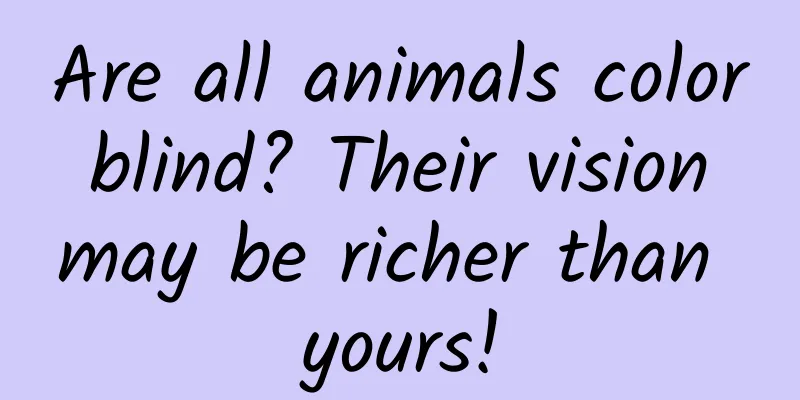Are all animals color blind? Their vision may be richer than yours!

|
Should I buy the same toy ball in red or green? What if my cat or dog doesn't like the color? I believe most "cat owners" have struggled with this question. Copyright image, no permission to reprint But I may have to tell you that your "master" will not mind whether the toy ball is red or green, because in their eyes, there is no difference between these two colors . 01 Are cats and dogs color blind? Aren't cats and dogs said to have excellent vision? Why can't they distinguish red from green? In fact, what we are talking about here is not vision, but a branch of vision - the ability to perceive color. This ability is called "color vision", or "color perception", or "color discrimination", which is our ability to perceive different wavelengths of light . When white light passes through a prism, it will be split into a colorful spectrum. Light of different wavelengths is arranged in sequence, from long to short: red, orange, yellow, green, cyan, blue, and purple. Of course, these are not simply seven colors, but there is a smooth transition between these colors. The colors we can see are far more than seven. Copyright image, no permission to reprint The reason we can recognize this color difference is because of the cones in our eyes. They are responsible for converting the colors we see into nerve impulses and transmitting them to the brain. There are three different types of cones on our retina, and they have different sensitivities to different wavelengths of light. Traditionally, scientists record them as short (S-), medium (M-) and long (L-) types according to the order of their wavelength sensitivity peaks. In layman's terms, they are generally called blue light, green light and red light receptors. It is these three receptors that antagonize and cooperate with each other that allow us to see the colorful world. However, compared to humans, cats and dogs lack one type of cone cell, and only have two types, long and short, which are sensitive to blue-violet light and yellow-green light respectively . This situation is very similar to patients with red-green color blindness in humans - they lack one of the medium or long cone cells, and therefore cannot distinguish red from green . Of course, we cannot be sure whether the color vision of cats and dogs is consistent with true human color blindness, and whether the rainbow they see is just a simple transition between yellow and blue, but at least they should not be able to distinguish whether the toy ball is red or green. Copyright image, no permission to reprint Cats and dogs are not only color blind, they are also "color weak" . The density of color cones in their retinas is much lower than that of humans. In the macula, the area of the retina that is most sensitive to color, the density of cones in dogs is only about one-tenth of that in humans. However, we cannot say that the world in the eyes of cats and dogs is gray. On the contrary, their vision can be very bright, even in a dim environment. In contrast to cones, there is another optical receptor on our retina, called rods. Although rods do not have the ability to recognize colors, they are more sensitive to light, and we can see things at night entirely thanks to them. There are many more rods distributed on the retinas of cats and dogs than humans , which is why they can still skillfully parkour in a dark room after turning off the lights. 02 "Dimensionality reduction attack" from birds When we sympathize with cats and dogs that the world is not colorful enough, the sparrows in the window also sympathize with us. If we humans are "trichromats", then most birds are "tetrachromats" . Compared to humans, birds have three types of color receptors, red, green and blue, as well as cones that respond to shorter wavelengths . In most birds, their peak response even falls into the ultraviolet range. Copyright image, no permission to reprint The existence of new cones adds a dimension to birds' perception of color. If the mixture of red, yellow and blue can be expressed on a plane, the mixture of four colors can only be expressed in three-dimensional space. Objects that appear gray to us may appear bright and colorful to birds, just as yellow objects appear bright red and green to dogs. There is also an advanced structure in the cones of birds that we mammals do not have. In front of the real color receptors in the cones of birds, there is a small oil droplet . This oil droplet may be dyed yellow to red by high concentrations of carotenoids, thus acting as a filter, making the color recognition of cones more accurate and specific. In the cones of birds, scientists have found a total of six small droplets of different colors, including one that is nearly colorless and transparent. The types of oil droplets in cones vary significantly among different bird species, and distantly related species may have more similar distributions of oil droplet types if they occupy similar ecological niches. Perhaps this is because, under the pressure of natural selection, oil droplets can change faster than cones. Of course, there are exceptions among birds. Owls have very few cones in their retinas, and most of them are rods that sense dim light, so owls' vision is likely to be close to monochrome - this is the same as cats. 03 The colorful night life of geckos? When it comes to high resolution over color, many nocturnal animals — including cats and owls — choose the former. But the gecko says, “I want both.” The helmeted gecko (Tarentola chazaliae), a nocturnal gecko, can recognize colors 350 times better than humans in dim moonlight. On their retinas, there are no rods that are sensitive to dim light, but instead, there are densely packed cones that are sensitive to three different wavelengths of light (although there are three types, they are not the red, green, and blue types in humans, but green, blue, and ultraviolet ). Copyright image, no permission to reprint The excellent optical properties of geckos' eyes allow them to experience the colorful world at night, and the cones in their eyes are large and dense. Scientists speculate that a branch of diurnal lizards may have found a suitable nocturnal ecological niche. In order to adapt to the new environment, they had to transform their congenitally defective visual system, using better optical systems and more powerful cones to overcome the trouble caused by the lack of rods. In the end, the effect looks pretty good. 04 Hardware is not enough, algorithms make up for it The eyes of cephalopods such as squid and octopus may seem similar in structure to ours, but they actually evolved independently - eyes have appeared independently many times in evolutionary history because they are so useful. In a way, the eyes of squids are more "reasonable" than those of vertebrates. The visual nerve fibers of vertebrates are located in front of the retina. These nerves gather into bundles and leave a "blind spot" on the retina when they pass through the retina to the optic nerve. However, the visual nerve fibers of squids and octopuses are located in the back of the retina and directly converge into the optic nerve without affecting the imaging at all . The intraocular structure of a vertebrate (left) and an octopus (right). You can see that the octopus's visual nerve fibers are located behind the retina. In the picture, 1 is the retina, 2 is the visual nerve fibers, 3 is the optic nerve, and 4 is the visual blind spot of vertebrates. Image source: Wikipedia But their eyes are not without problems. Cephalopods have only one type of optical receptor in their eyes, which means they can only see black and white and grayscale. They are even worse than dogs. But if you know a little about the color-changing habits of squids, it is hard not to wonder: if they cannot see colors, how do they change their colors to match the environment? Why do they have to show off their colorfulness in front of the opposite sex who are also color blind - obviously, fish predators can see more easily? Faced with such a contradiction, scientists pointed out that squids and octopuses may also have color vision, and the secret lies in their strange-shaped pupils . The pupils of most vertebrates are round, which makes it easier to focus light on one point and obtain a clearer image. However, the pupils of squids are completely the opposite, with U-shaped and W-shaped pupils . Such pupils are difficult to form a simple and clear image on the retina, and will form colorful halos at the edge of the image due to the inconsistency of light wavelengths. Copyright image, no permission to reprint As long as there is enough "computing power", these halo patterns can accurately restore the color of the object itself, of course, this also has certain requirements for the color itself. If it is a single color, or two colors with similar brightness, it is difficult for them to form obvious vignettes, which is why some research reports say that squids do not have color vision; squids are good at identifying the colors at the junction of light and dark, which is the same scene when our cameras encounter the purple fringing problem. 05 The most complex color vision is actually... Mantis shrimps , or mantis shrimps (members of the order Stomatopoda), may be the most complex group of animals on Earth with color vision, as they have as many as 12 to 16 different optical receptors. We can't imagine what the rainbow in their eyes looks like, not to mention the mixture of more than a dozen dimensions of visible light and ultraviolet light, they can even perceive circularly polarized light - they are still the only group with this special ability. Copyright image, no permission to reprint Such complex color vision can not only save precious computing power for their small brains, but also provide them with a richer way of secret communication. Every cave where mantis shrimp live may have a big "Do Not Disturb" sign written on the door, but their natural enemies, prey, and us cannot see it. Each animal has its own innate way of perceiving the world. Forcing our perspective to fit in with ours is an unnecessary burden on us and them. So for a red ball or a green ball, why not buy a color you like, and don’t stand too much in the other’s perspective; or, buy both and see which one you like better? Author|Laomao Review | Huang Chengming, Researcher at the Institute of Zoology, Chinese Academy of Sciences The cover image and the images in this article are from the copyright library Reproduction of image content is not authorized |
<<: Huaxi doctors warn you to be careful when eating crabs! Especially this may be life-threatening
Recommend
Apple releases iOS 12 GM version: officially pushed on September 18
At Apple's Gather Round conference early this...
Will the “Snow Country” come?
On March 20, 2023, the last assessment product of...
With less than 200,000 units sold in a year, where will CANTV go under the halo of the national team?
In the past two years, more than a dozen new bran...
Creative advertising materials for the Meiyu Women’s Platform!
As women’s education and employment levels improv...
Mobile games enter XBOX ONE? How far can the next generation of "TV boxes" go?
Whether it is the previous generation XBOX 360 or...
Weird Talks | Interesting Talks on Numbers, Lucky and Unlucky Numbers in the East and the West, Why Does “250” Refer to a Stupid Person?
Hello everyone, today I have brought you a "...
After half a year, the flagship is still fragrant, Sony 65 X8500G TV is experienced again
When buying a TV, look at Sony. For the large scr...
RRS Enterprise Account: Everyone is a Marketing Treasure [WeChat Enterprise Account Case]
1. “Renren Marketing” By using enterprise account...
The competition for multi-core smartphones stalls, putting MediaTek at a disadvantage
As mobile phone hardware performance shows signs ...
Please save these tips for achieving mobile app user growth!
When traffic and users in various industries are ...
I don't have to worry about breast cancer because no one in my family has had it? Is breast cancer a terminal illness? The truth is...
With the improvement of living standards and heal...
"Academy of Agricultural Sciences delicacies" are popular, but the quality is not up to standard? The truth is here
In recent years, many netizens have discovered th...
700 paying users and 1,000 UGC operation cases in 3 months, how did they do it?
I have seen many products that were poorly made. ...
What should operators do before, during and after an online event?
Today, taking online activities as an example, le...









